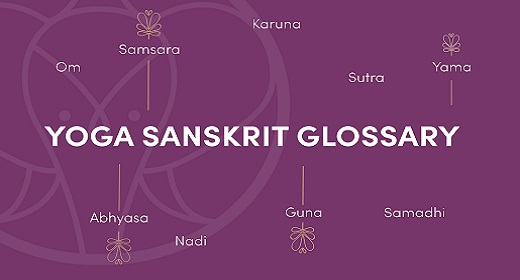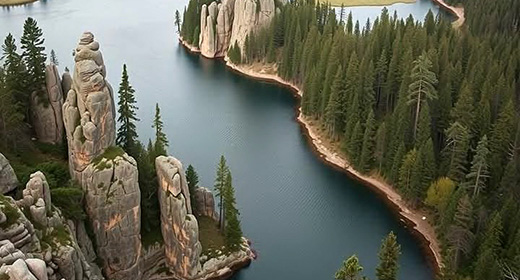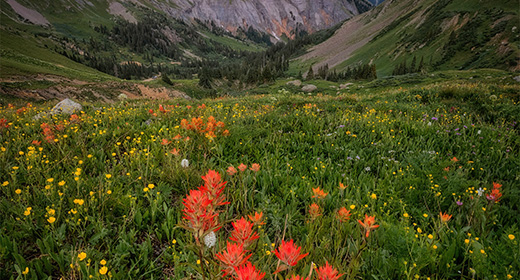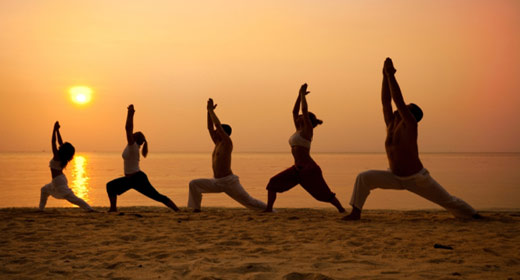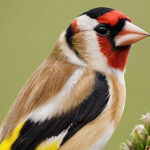You may be in a yoga class and hear the teacher using Sanskrit words for yoga poses (asanas) and concepts…
This list should help you to understand some of the more commonly used terms.
| Adho-mukha | Face downwards. |
| Adho-mukha svanasana | Downward facing dog pose. |
| Anga | The body; a limb or a part of the body; a constituent part. |
| Apana | One of the vital airs which move in the sphere of the lower abdomen. |
| Ardha | Half. |
| Asana Posture | The third stage of yoga. |
| Asta | The number eight. |
| Astanga Yoga | The eight limbs of Yoga described by Patanjali. |
| Aum | Like the Latin word ‘Omne’, the Sanskrit word ‘Aum’ means ‘all’ and conveys concepts of ‘Omniscience’, ‘Omnipresence’ and ‘Omnipotence’. |
| Baddha | Bound, caught, restrained, firm. |
| Bakasana | Elbow balancing pose. |
| Balasana | Child’s pose. |
| Bandha | Bondage or fetter. It means a posture where certain organs or parts of the body are contracted and controlled. |
| Bhakti | Worship, adoration. |
| Bhuja | The arm or the shoulder. |
| Bhuja-pida | Pressure on the arm or shoulder. |
| Bhujanga | A serpent, a snake. |
| Bhujangasana | Cobra pose. |
| Chakra | Literally, a wheel or circle. Energy (prana) is said to flow in the human body through three main channels (nadis), namely, Susumna, Pingala and Ida. Susumna is situated inside the spinal column. Pingala and Ida start respectively from the right and left nostrils, move up to the crown of the head and course downwards to the base of the spine. These two nadis intersect with each other and also the Susumna. These junctions of the nadis are known as chakras or the fly-wheels which regulate the body mechanism. |
| Chandra | The moon. |
| Chatur | The number four. |
| Chaturanga | Four limbs; a push-up position a few inches off the ground. |
| Chitta | The mind in its total or collective sense, being composed of three categories: (a) Mind, having the faculty of attention, selection and rejection; (b) Reason, the decisive state which determines the distinction between things and (c) Ego, the I-maker. |
| Danda | A staff. |
| Dhanu | A bow. |
| Dharana | Concentration or complete attention. The sixth stage of Yoga mentioned by Patanjali. |
| Dhyana Meditation | The seventh stage of Yoga mentioned by Patanjali. |
| Dwi | Two, both. |
| Dwi-hasta | Two hands. |
| Dwi-pada | Two feet or legs. |
| Eka | One, single, alone, only. |
| Gu | First syllable in the word ‘Guru’, meaning darkness. |
| Guru | Spiritual preceptor, one who illumines the darkness of spiritual doubt. |
| Ha | First syllable of the word ‘Hatha’, which is composed of the syllables ‘ha’ meaning the sun, and ‘tha’ meaning the moon. The object of Hatha-yoga is to balance the flow of solar and lunar energy in the human system. |
| Hala | A plough. |
| Hasta | The hand. |
| Hatha | Sun/moon; balance. |
| Hatha-yoga | The way towards realisation through rigorous discipline. |
| Janu | The knee. |
| Jnana | Sacred knowledge derived from meditation on the higher truths of religion and philosophy, which teaches a man how to understand his own nature. |
| Kapota | A dove, pigeon. |
| Karma | Action. |
| Karma-yoga | The achievement of union with the Supreme Universal Soul through action. |
| Karna | The ear; also one of the heros in the Mahabharata. |
| Karna Pidasana | Pressure on ears pose. |
| Kriya | An expiatory rite, a cleaning process. |
| Kundalini | The Kundalini (kundala=coil of a rope; Kundalini=a coiled female serpent) is the divine cosmic energy. This force or energy is symbolised as a coiled and sleeping serpent lying dormant in the lowest nerve centre at the base of the spinal column, the Muladhara-chakra. This latent energy has to be aroused and made to ascend the main spinal channel, the Susumna piercing the chakras right up to the Sahasrara, the thousand-petalled lotus in the head. Then the Yogi is in union with the Supreme Universal Soul. |
| Mala | A garland, wreath. |
| Mandala | A circle. |
| Mantra | A sacred thought or a prayer. |
| Matsya | A fish. |
| Mudra | A seal; a sealing posture. |
| Mukha | Face. |
| Nama | Name. |
| Namaste | Commonly said at the end of yoga class by the instructor and the students. One beautiful interpretation: I honor that place in you where the whole Universe resides. And when I am in that place in me and you are in that place in you, there is only one of us. |
| Nava | A boat. |
| Nirodha | Restraint, suppression. |
| Niyama | Self-purification by discipline. The second stage of yoga mentioned by Patanjali. |
| Pada | The foot or leg; also part of a book. |
| Padangustha | The big toe. |
| Padma | A lotus. |
| Parigha | A beam or a bar used for bolting or shutting a gate. |
| Parighasana | Lateral side stretch. |
| Paripurna | Entire, complete. |
| Paripurna Navasana | Boat pose. |
| Parivrtta | Turned around, revolved. |
| Parivrtta Trikonasana | Twisting triangle. |
| Parsva | The side, flank; lateral. |
| Pasa | A fetter, trap, noose. |
| Paschima | West; the back side of the body. |
| Paschimottana | Intense stretch of the back side of the body from the nape to the heels. |
| Paschimottanasana | Seated forward bend. |
| Patanjali | The author of the yoga sutras. The propounder of Astanga yoga. He put it on paper, so the world could experience it. |
| Pida | Pain, suffering, pressure. |
| Prajna | Intelligence, wisdom. |
| Prana | Breath, respiration, life, vitality, wind, energy, strength. It also connotes the soul. |
| Pranayama | Rhythmic control of the breath. The fourth stage of yoga. |
| Prasarita | Spread out, stretched out. |
| Pratyahara | Withdrawal and emancipation of the mind from the domination of the senses and sensual objects. The fifth stage of yoga. |
| Purva | East, the front of the body. |
| Purvottana | The intense stretch of the front side of the body. |
| Purvottanasana | Pose of the intense stretch of the front side of the body. |
| Raja | A king, a ruler. |
| Raja-kapota | King pigeon. |
| Raja-yoga | The achievement of union with the Supreme Universal Spirit, by becoming the ruler of one’s own mind by defeating its enemies. The chief of these enemies are: Kama (passion or lust), krodha (anger or wrath), lobha (greed),moha (delusion), mada (pride) and matsara(jealousy or envy). The eight-fold yoga of Patanjali shows the royal road (raja-marga) for achieving this objective. |
| Ru | The second syllable in the word ‘guru’, meaning light. |
| Salabha | A locust. |
| Salamba | With support. |
| Samadhi | A state in which the aspirant is one with the object of his meditation, the Supreme Spirit pervading the universe, where there is a feeling of unutterable joy and peace. |
| San | Six. |
| Sarva | All, whole. |
| Sarvanga | The whole body. |
| Sarvangasana | Shoulderstand. |
| Sava | A corpse, a dead body. |
| Savasana | Corpse pose. |
| Setu | A bridge. |
| Setu-bandha | The construction of a bridge. Name of an asana in which the body is arched. |
| Siddha | A sage, seer or prophet; also a semi-divine being of great purity and holiness. |
| Sirsa | The head. |
| Supta | Sleeping. |
| Supta Virasana | Supine hero pose. |
| Surya | The sun. |
| Svana | A dog. |
| Tada | A mountain. |
| Tadasana | Mountain pose; standing tall. |
| Tan | To stretch, extend, lengthen out. |
| Tapas | Burning away impurities through self-discipline. |
| Tha | The second syllable of the word ‘hatha’. The first syllable ‘ha’ stands for the sun, while the second syllable ‘tha’ stands for the moon. The union of these two is Hatha-yoga. |
| Tola | A balance. |
| Tri | Three. |
| Trikona | A triangle. |
| Ujjayi | A type of pranayama in which the lungs are fully expanded and the chest is puffed out. |
| Upavistha | Seated. |
| Urdhva | Raised, elevated, tending upwards. |
| Urdhva-mukha | Face upwards. |
| Ustra | A camel. |
| Ut | A particle, denoting intensity. |
| Utkata | Powerful, fierce. |
| Uttana | An intense stretch. |
| Uttanasana | Standing forward bend intense stretch. |
| Utthita | Raised up, extended, stretched. |
| Vajra | A thunderbolt, the weapon of Indra. |
| Vasistha | A celebrated sage, author of several Vedic hymns. |
| Vira | A hero; brave. |
| Virabhadra | A powerful hero created out of Siva’s matted hair. |
| Virabhadrasana I | Warrior I pose. |
| Vrksa | A tree. |
| Vritta | Fluctuation. |
| Yama | The god of death. Yama ia also the first of the eight limbs or means of attaining yoga. Yamas are universal moral commandments or ethical disciplines transcending creeds, countries, age and time. The five mentioned by Patanjali are: non-violence, truth, non-stealing, continence and non-coveting. |
| Yoga | Union, communion. |
| Yoga-mudra | A posture. |
| Yogi or Yogini | One who follows the path of yoga. |







